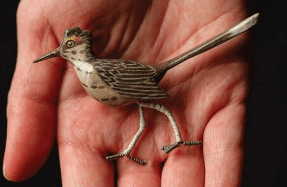OVER HEATED


IN MARICOPA COUNTY, ARIZONA, where a high school student named Gabe Arroyo lives, all the houses have roofs covered in solar panels and walls with built-in battery storage. Large metal energy collectors, shaped like satellites, sprout amid cacti in the yards. They follow the sun like flowers throughout the day, gathering as much energy as possible before they close up at night.
Arroyo’s mother, Elena, is the deputy chief environmental marshal in Arizona. One morning in autumn, she took her son and one of his classmates to a power plant on the western outskirts of Phoenix, so they could record a video for a school project on energy and sustainability while she worked. When they left the house, it was already 101 degrees Fahrenheit; temperatures here can often reach up to 130. Everything Gabe wore was a bright cherry-red: jacket and long pants, topped with a fedora. When his classmate commented, Gabe explained that his clothing was solar-reflective, designed to protect him from the heat. Elena wore a solar-reflective green dress and a wide-brimmed hat.
That summer, two fires at the power plant caused blackouts that left millions of people in the area without air conditioning. “Even with all our storage capacity, if the energy-supply system fails, things shut off, especially climate-control systems in buildings,” Gabe told his classmate. “The toll taken by these failures is no joke.”
The plant was a graveyard of sustainable-energy technology, all set against the desert’s red-rock formations. According to Elena, county officials did not always prioritize sustainability over politics when choosing energy sources. Gabe recounted the history of the Palo Verde nuclear plant, built in 1976, for his video. Despite being out of use for years, it has never been fully decommissioned and still stored radioactive waste. “It’s not alive anymore,” he said, “but it’s not completely dead, either.” There were other kinds of infrastructure still in use, including parabolic troughs and a series of cylindrical solar towers several stories high. Like nuclear power, solar comes with its own trade-offs; the towers regularly incinerated birds that flew too close, and their deaths could have a large ripple effect in the ecosystem.
It was Elena’s job to uncover the cause of the fires, and she determined, with Gabe’s help, that the solar tower’s operating system was to blame. The technology was designed to be self-combusting in order to minimize its ecological damage. “But this, this will kill a lot of people,” Gabe said, thinking about the power outages. That day, Gabe made a pledge to work toward better energy solutions, ones that did not pit people against the environment.
If Gabe’s promise sounds unusually aspirational, it’s because he’s a character in a comic book created to teach climate literacy and the future of solar energy to Arizona fifth through eighth graders. Drawn Futures: Arizona 2045 was written by Gary Cohn and C. Edward Sellner and drawn by Mauro Mandalari; it is one of several projects by the Center for Science and the Imagination, a multidisciplinary hub at Arizona State University in Tempe that fosters collaboration between scientists, engineers, science fiction writers and others. One of the center’s main goals is to use fiction to devise solutions to not-so-fictional problems. “For us, that means embracing the idea that there’s a variety of possible futures and seeing that as a place for critical thinking,” Joey Eschrich, editor and program manager for the center, told me. “It’s kind of an empowering idea, that we can still steer the future in some way, that our decisions matter. We’re not running down a prescribed path that’s preordained.”
and isn’t here yet, but it’s quickly approaching. This summer, a heat dome — one of the technical climate terms that has filtered into our vernacular—descended onto the U.S., subjecting most of the Lower 48 states
You’re reading a preview, subscribe to read more.
Start your free 30 days





